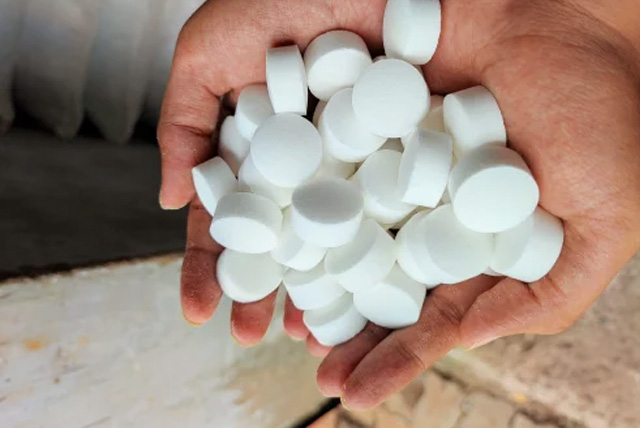So, you’ve planning to invest in a water softener – fantastic! Soft water offers a multitude of benefits for your home, from tackling stubborn soap scum to extending the lifespan of your appliances. But you might be wondering, why does my water softener need salt? After all, it doesn’t seem like there’s any salting involved in the softening process!
Fear not, the answer is quite simple – salt plays a crucial role in the regeneration process that keeps your water softener functioning at its peak. Let’s delve into the fascinating world of ion exchange and discover how a bit of salt goes a long way in ensuring you enjoy the endless benefits of soft water.
Understanding Hard Water: The Troublemaker
Before we dive into the hero (salt!), let’s meet the villain – hard water. Hard water is packed with dissolved minerals, primarily calcium and magnesium. While these minerals are essential for our health, they can wreak havoc in our homes. They cause that dreaded soap scum buildup, leave unsightly spots on dishes and glasses, and can even shorten the lifespan of your precious appliances.
The Magic of Ion Exchange: How Water Softeners Work
Water softeners employ a clever process called ion exchange to remove these troublemaking minerals. Here’s a breakdown of the key players:
- Resin Beads: The heart of your water softener is a tank filled with tiny resin beads. These beads are like tiny magnets, specifically attracted to calcium and magnesium ions (the charged particles of these minerals).
- Sodium Ions: Here’s where our salty hero comes in! Salt, also known as sodium chloride (NaCl), is separated into its two components – sodium (Na) and chloride (Cl) ions – when dissolved in water.
Now, the magic happens:
- Hard Water Enters the Tank: Hard water flows through the tank containing the resin beads.
- Ion Exchange: The calcium and magnesium ions in the hard water are attracted to the resin beads and swap places with the sodium ions clinging to the beads. This essentially traps the hardness minerals while releasing sodium back into the water.
- Softened Water Exits: The water leaving the tank is now “soft” because it’s free of the calcium and magnesium that caused the problems in the first place.
Regeneration: Keeping the Magic Alive
This ion exchange process is fantastic, but it’s not a one-time deal. Over time, the resin beads become saturated with calcium and magnesium ions, losing their ability to capture more. This is where the salt comes back into play – it’s time for regeneration!
Here’s how regeneration keeps your water softener fighting fit:
- Brine Tank: Your water softener has a separate tank dedicated to holding a brine solution – a mixture of water and salt.
- Backwashing: The regeneration cycle starts with backwashing. Here, water is flushed backward through the resin tank, dislodging trapped hardness minerals on the beads.
- Brine Rinse: The real magic happens now. The brine solution from the separate tank is drawn into the resin tank. Remember those sodium ions we mentioned earlier? They eagerly replace the trapped calcium and magnesium clinging to the resin beads.
- Rinsing and Ready: Finally, the system rinses away the displaced hardness minerals and any leftover brine solution. Your water softener is now recharged and ready to deliver soft water for another cycle!
Salt: The Unsung Hero of Soft Water
So, there you have it! Salt isn’t directly added to your softened water. Instead, it plays a vital role behind the scenes, acting as the key ingredient in the regeneration process. By constantly replenishing the sodium ions on the resin beads, salt ensures your water softener can continuously capture hardness minerals and deliver the benefits of soft water throughout your home.
Different Types of Salt for Water Softeners
Now that you know the importance of salt, let’s explore the different types available for your water softener:
- Evaporated Salt (Solar Salt): This is a natural and pure form of salt, often favoured for its minimal environmental impact.
- Rock Salt: A more economical option, rock salt can be less refined and may contain impurities. Ensure you choose a type specifically designed for water softeners to avoid damaging the system.
Here are some additional tips for choosing salt for your water softener:
- Follow the manufacturer’s recommendations: Different water softeners may have specific salt requirements.
- Consider water hardness: If you have very hard water, a higher grade of salt might be recommended for optimal performance.
- Purity matters: Choose a clean, high-purity salt to avoid clogging the brine tank or damaging your water softener.
- Think about convenience: Pelletized salt dissolves quicker and can be easier to manage than large rock salt crystals.
We’re Always at Your Support
At Hydrotech Water Services, we understand the importance of soft water for your home. We offer a wide range of high-quality water softeners and water treatment solutions to ensure you enjoy all the benefits of soft water.
If you have any questions about water softeners, salt types, or the benefits of soft water, please don’t hesitate to contact our friendly team.

